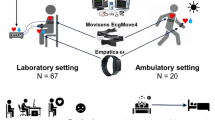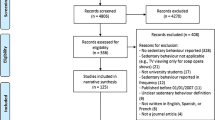Abstract
This research aims to accurately predict energy consumption according to physical activity intensity in daily life using an accelerometer. To derive a simple but accurate equation for prediction of correlations between acceleration information and energy consumption according to physical activity intensity, the following practices have been undertaken in this research. First, an experiment has been conducted with accelerometers attached at the waist and wrist. Second, 13 motions in daily life with different physical activity intensities were performed. The experiment was conducted on 20 healthy persons using a respiratory gas analyzer for measurement of actual energy consumption. As a predictive model for energy consumption, a multiple regression equation was developed using accelerometer data and physical information about the subjects. For comparison between single accelerometer attached at the waist and two accelerometers attached at the wrist and waist, the correlation between actual energy consumption and accelerometer output for the former was 0.911 and that for the latter was 0.914, which is not significantly different. This result implied that one accelerometer attached at the waist is practically efficient in terms of prediction of energy consumption. As a result of comparison between a single regression equation without motion classification and several regression equations with inclusive motion classification, it was found that several regression equations showed smaller errors (0.64 vs 0.18). Thus for accurate and practical prediction of energy consumption, it is recommended to use several regression equations with inclusive motion classification and single accelerometer attached at the waist.
Similar content being viewed by others
References
World Health Organization, “Reducing risks, promoting healthy life,” World Health Report, 2002.
Petrella, R. J., “Exercise for older patients with chronic disease,” Physician & Sports Medicine, Vol. 27, No. 11, pp. 79–102, 1999.
Choi, J. S., Oh, H. S., Kang, D. W., Mun, K. R., Choi, M. H., Lee, S. J., Yang, J. W., Chung, S. C., Mun, S. W. and Tack, G. R., “Comparison of gait and cognitive function among the elderly with Alzheimer’s Disease, Mild Cognitive Impairment and Healthy,” Int. J. Precis. Eng. Manuf., Vol. 12, No. 1, pp. 169–173, 2011.
Crouter, S. E., Clowers, K. G. and Bassett, D. R., “A novel method for using accelerometer data to predict energy expenditure,” Journal of Applied Physiology, Vol. 100, No. 4, pp. 1324–1331, 2006.
Staudenmayer, J., Pober, D., Crouter, S., Bassett, D. and Freedson, P., “An artificial neural network to estimate physical activity energy expenditure and identify physical activity type from an accelerometer,” Journal of Applied Physiology, Vol. 107, No. 4, pp. 1300–1307, 2009.
Madorikawa, T., Tanaka, S., Kaneko, K., Ishikawa-Takawa, K., Futami, J. and Tabata, I., “Evaluation of low-intensity physical activity by triaxial accelerometry,” Obesity, Vol. 15, No. 12, pp. 3031–3038, 2007.
Bassett, D. R., Ainsworth, B. E., Swartz, A. M., Strath, S. J., O’Brien, W. L. and King, G. A., “Validity of four motion sensors in measuring moderate intensity physical activity,” Medicine & Science in Sports & Exercise, Vol. 32, Suppl. 9, pp. 471–480, 2000.
Hendelman, D., Miller, K., Baggett, C., Debold, E. and Freedson, P., “Validity of accelerometry for the assessment of moderate intensity physical activity in the field,” Medicine & Science in Sports & Exercise, Vol. 32, Suppl. 9, pp. 442–449, 2000.
Rowlands, A. V., Thomas, P. W., Eston, R. G. and Topping, R., “Validation of the RT3 Triaxial Accelerometer for the Assessment of Physical Activity,” Medicine & Science in Sports & Exercise, Vol. 36, No. 3, pp. 518–524, 2004.
Karantonis, D. M., Narayanan, M. R., Mathie, M., Lovell, N. H. and Celler, B. G., “Implementation of a real-time human movement classifier using a triaxial accelerometer for ambulatory monitoring,” IEEE Transactions on Information Technology in Biomedicine, Vol. 10, No. 1, pp. 156–167, 2006.
Mathie, M. J., Celler, B. G., Lovell, N. H. and Coster, A. C., “Classification of basic daily movements using a triaxial accelerometer,” Medical & Biological Engineering & Computing, Vol. 42, No. 5, pp. 679–687, 2004.
Najafi, B., Aminian, K., Paraschiv-Ionescu, A., Loew, F., Bula, C. J. and Robert, P., “Ambulatory system for human motion analysis using a kinematic sensor: monitoring of daily physical activity in the elderly,” IEEE Transactions on Biomedical Engineering, Vol. 50, No. 6, pp. 711–723, 2003.
Pober, D. M., Staudenmayer, J., Raphael, C. and Freedson, P. S., “Development of novel techniques to classify physical activity mode using accelerometers,” Medicine & Science in Sports & Exercise, Vol. 38, No. 9, pp. 1626–1634, 2006.
Kang, D. W., Choi, J. S., Lee, J. W., Chung, S. C., Park, S. J. and Tack, G. R., “Real-time elderly activity monitoring system based on a tri-axial accelerometer,” Disability and Rehabilitation: Assistive Technology, Vol. 5, No. 4, pp. 247–253, 2010.
Author information
Authors and Affiliations
Corresponding author
Rights and permissions
About this article
Cite this article
Kang, DW., Choi, JS., Lee, JW. et al. Prediction of energy consumption according to physical activity intensity in daily life using accelerometer. Int. J. Precis. Eng. Manuf. 13, 617–621 (2012). https://doi.org/10.1007/s12541-012-0079-2
Received:
Accepted:
Published:
Issue Date:
DOI: https://doi.org/10.1007/s12541-012-0079-2




